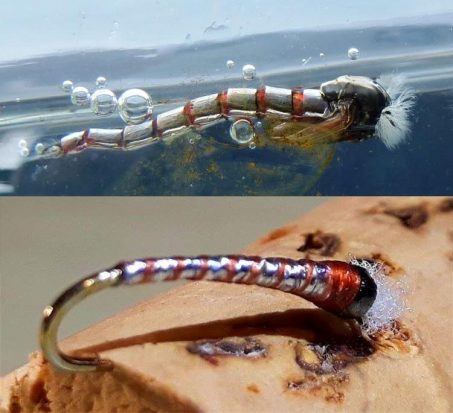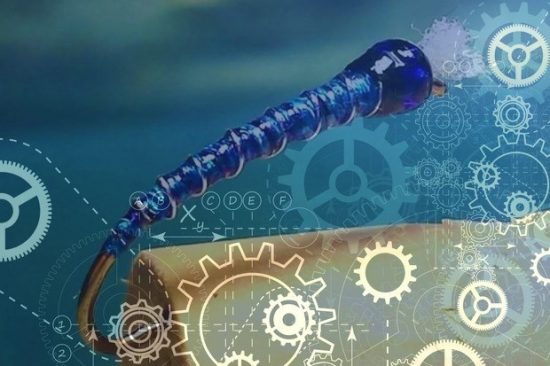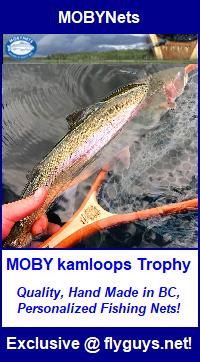Chironomid Pupa Fly Tying Tips
– Building a Better Chironomid Fly –
Reflecting back on the highlights of our recently completed 2018 Introduction to Chironomid Fly Fishing seminar, I noted participant interest in the chironmid pupa fly tying tips section of the course. Brandyn must of caught it as well because before I even mentioned it to him he had already pumped out three videos focused on tips & tricks for tying the cone, gilled and buzzer style chironomid pupae flies. It was settled then, and with spring and ice off on the horizon the timing couldn’t be better for a chironomid pupa fly tying tips article. 😉
If you’re new to fly tying pay attention as these chironomid pupa fly tying tips are sure to flatten your learning curve to tying effective chronie fly patterns. And even if you are a seasoned fly tier, check it out anyway; who knows there just might be something in it that you’ve never thought of before, or perhaps you could contribute to the tips provided in this article by adding your own chironomid pupa fly tying tips for us in the comments section at the end of the post. 😉
Chironomid Pupa Fly Tying Tips | Common Concepts:
 Today’s chironomid pupae flies generally fall into three main categories; 1) the ice cream cone chironomid pupa fly 2) the bead & gill chironomid pupa fly and 3) the more traditional style buzzer chironomid pupa fly. In each case there are common traits that can make or break the success of the imitation. These common traits consists of things such as proportion, thorax to body size ratio, taper, and segmentation. The following are some suggestions specific to these common chironomid pupa tying concepts …
Today’s chironomid pupae flies generally fall into three main categories; 1) the ice cream cone chironomid pupa fly 2) the bead & gill chironomid pupa fly and 3) the more traditional style buzzer chironomid pupa fly. In each case there are common traits that can make or break the success of the imitation. These common traits consists of things such as proportion, thorax to body size ratio, taper, and segmentation. The following are some suggestions specific to these common chironomid pupa tying concepts …
Bead to Hook Style & Size:
Gill = Length of bead or thorax.
Taper = Bead thickness at head to hook thickness at hook bend.
Thread to Hook Size:
Scud Hooks #10 and smaller = Ultra 70 | Uni 8/0 | Danville Fly Master 70
Scud Hooks #8 and larger = Ultra 140 | Uni 6/0 | Danville Plus 140
2X Hooks #12 and smaller = Ultra 70 | Uni 8/0 | Danville Fly Master 70
2X Hooks #12 and smaller = Ultra 140 | Uni 6/0 | Danville Plus 140
Regardless of the chironomid pupa fly style that you are tying, the application of these common concepts should assist to achieve a fairly proportionally accurate imitation. Specifically, each of the three chironomid pupa fly pattern styles also have their own individual tips & tricks which can further assist to make the offerings more appealing to trout. We will go through each style one by one …
Chironomid Pupa Fly Tying Tips | Ice Cream Cone:
The ice cream cone style chironomid pupa fly is probably the simplest version of the pupa fly to tie. In this version a white bead is used to represent the white gills of the natural and the body is tied in behind it.
Common thought pattern around when to use a white bead over a black bead with added gill is 1) when visibility is impaired (mukey water lakes) and 2) when suspended particle in the water clog up fiber gills. Having said that there are certainly those that use them exclusively with great success. Having a few of each in the tickle trunk is always a good idea!
Ice cream cone chironomid pupa fly tying tips as follows …
Chironomid Pupa Fly Tying Tips | Bead & Gill:
In the Bead & Gill version of the chironomid pupa fly, a white material, typically a fiber of some sort, is used to represent the natural gills. This material is usually positioned above a brass bead of varying colours, most commonly black.
Bead & gill chironomid pupa flies are typically chosen when fly fishing clear water lakes. The theory is that, as visibility is good, fish are better able to observe detail and therefore the more natural in appearance the imitation the more success it should have. Again, although this might be the case most of the time there will certainly be days when ice cream cone cronies outperform bead & gill style flies in clear water lakes so a diverse inventory is recommended!
Bead & gill chironomid pupa fly tying tips are as follows …….
Chironomid Pupa Fly Tying Tips | Traditional (Buzzer):
The more traditional buzzer style chironomid pupa fly omits the bead in favour of thread or other materials to represent the thorax and gills of the natural.
Recently gaining more and more traction the Buzzer style chironomid pupa fly, due to it’s strikingly realistic properties, is thought to be the front runner when the trout are being extremely fussy. As this is a new phenomenon, for us anyway, it’s hard to believe that the extra little detail could really make that much of a difference, but I would hate to the guy on the water without one on the day when the trout decide to prove me wrong!
Specific Buzzer chironomid pupa fly tying tips are as follows …….
There you have it folks, some common and style specific chironomid pupa fly tying tips for the ice cream cone, bead & gill and traditional buzzer cronie fly patterns. Will these little tricks and tweaks always make a difference? Most probably not. But when the fish are being picky they just might make all the difference in the world!
Tight lines from team flyguys! (*videos by Brandyn 😉 )
*** for more still water fly fishing strategies please hit up & review our still water fly fishing category here!
*** if you’re interested in custom tied, time tested & proven effective BC Interior fly patterns, but would rather buy than tie, please Contact us for details!
*** for more effective BC stillwater fly fishing patterns be sure to check out all of flies on our BCs best fly patterns index page!
Like our stuff? Subscribe by ![]() Feed or
Feed or ![]() Email
Email .jpg)











